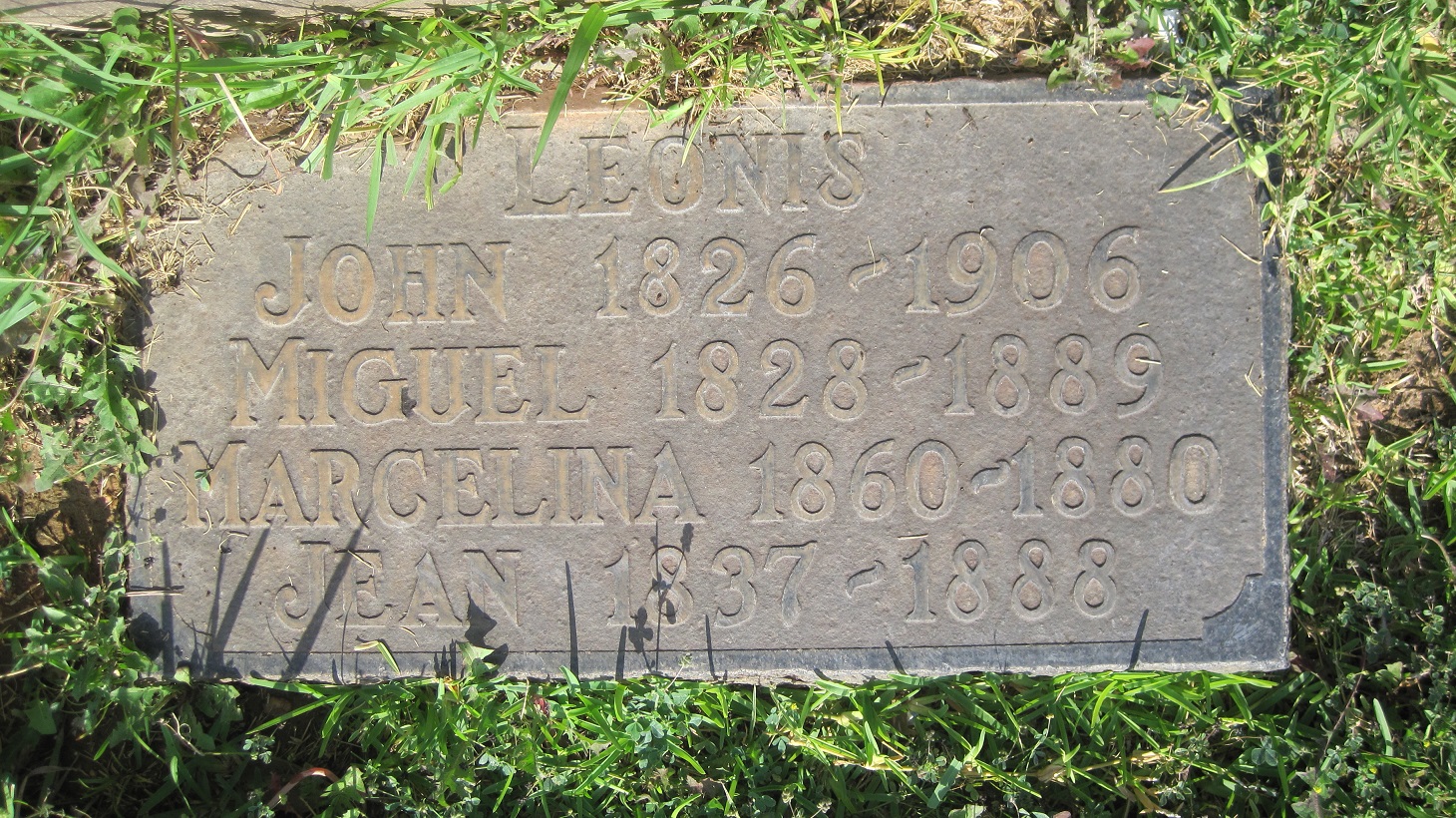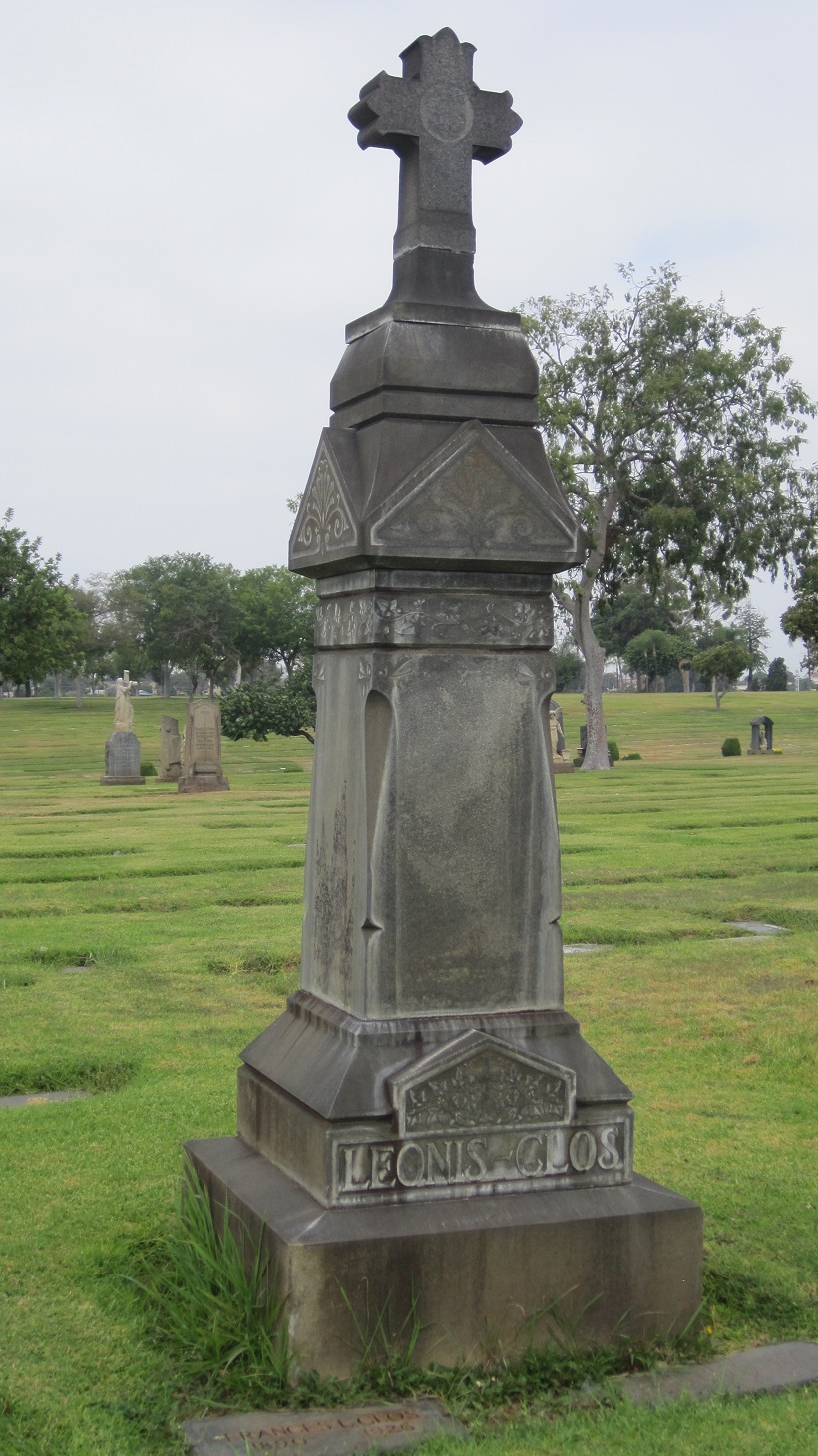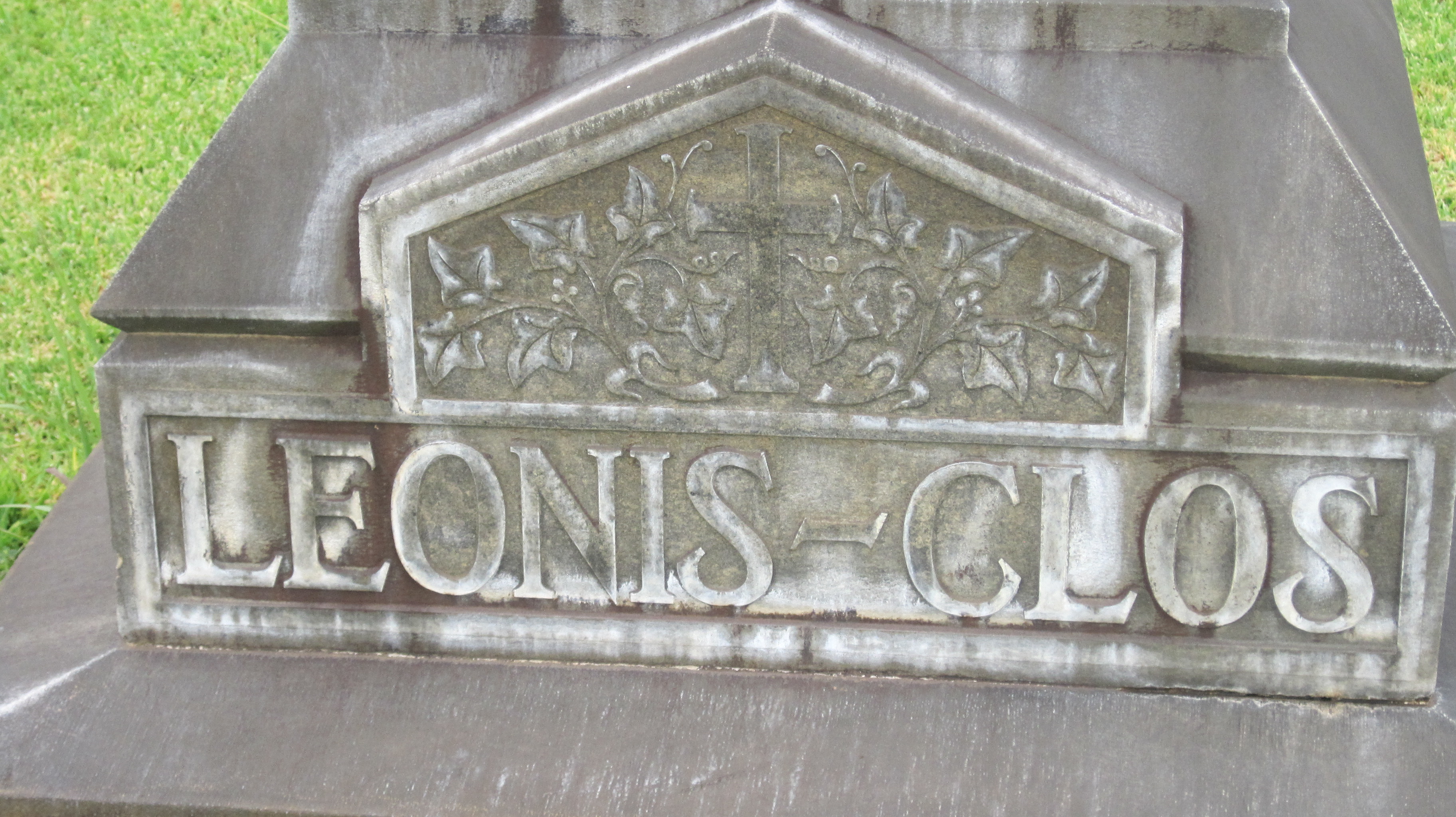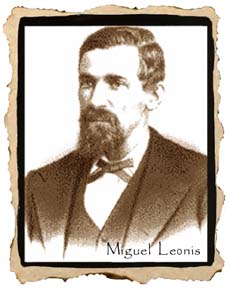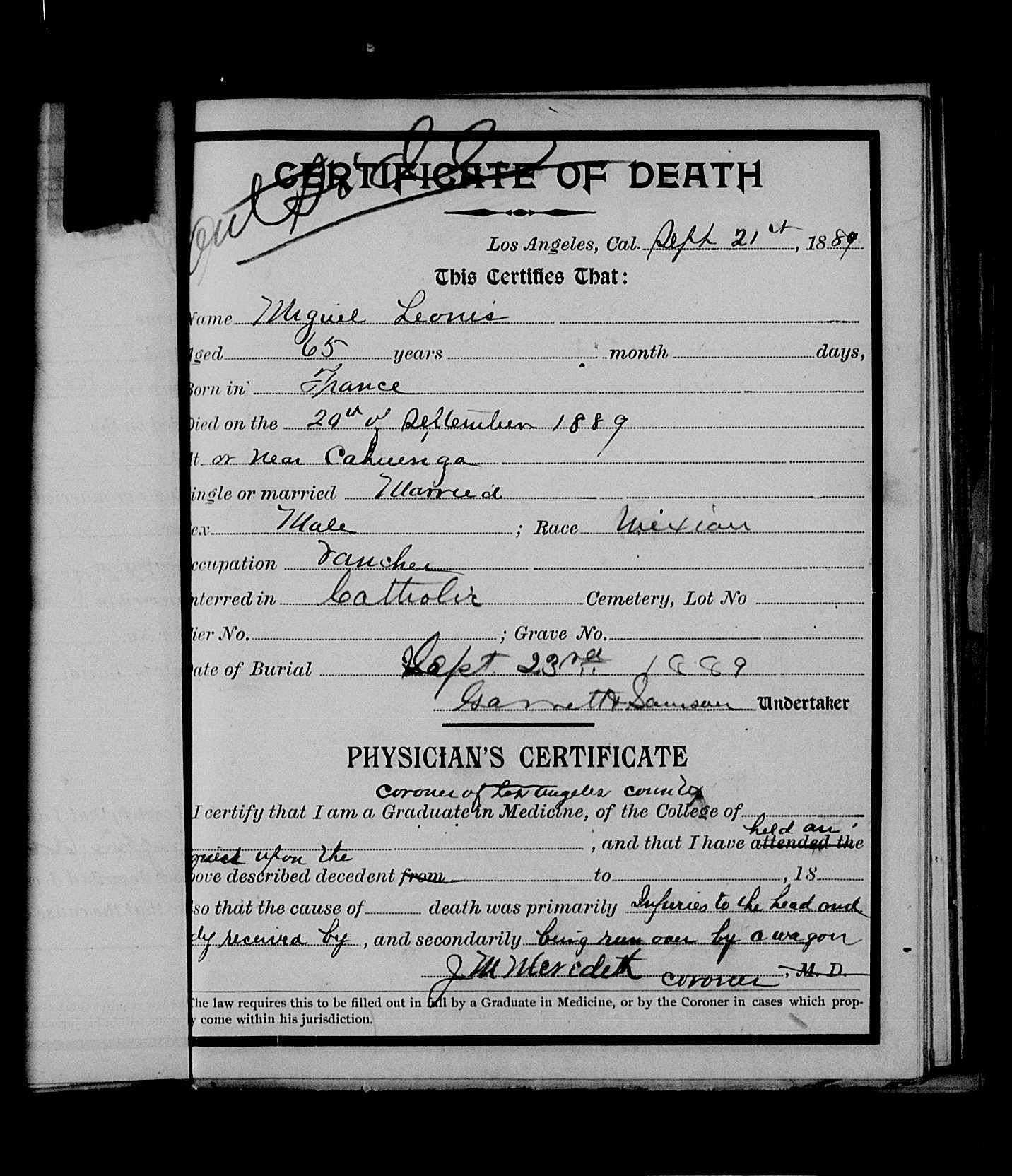The Leonis family was wealthy and greatly respected. Leonis' father was a high ranking official in the government. When Leonis was a young man he became involved in the smuggling trade. By the time he was twenty years old, he led a profitable operation, trafficking contraband back and forth across the mountainous and isolated border dividing France and Spain. His reputed illicit activities brought shame to the Leonis family name and he was compelled to leave the country at his father's request. It was also possible that the authorities were after him and he fled to avoid prosecution. When Leonis arrived in Los Angeles, he went to work as a sheepherder for a man named Joaquin Romero, who owned half of Rancho El Escorpion.
Leonis, as both a legendary and historical figure, was one of the most colorful of the early land settlers and pioneers of Los Angeles and the San Fernando Valley. A Basque who stood six-feet, four inches tall, with piecing green eyes. He was dauntless and physically powerful and possessed shrewdness and drive. For years during the late 1800s, he controlled and ruled much of the west end of the San Fernando Valley and part of what is now adjoining Ventura County. His home and headquarters was the Leonis Adobe, which he guarded like a feudal baron with his army of around one hundred Mexicans and Indians.
Leonis married Espiritu Chijulla, a Native American Indian widow who had inherited the Rancho El Escorpion upon the death of her husband. She was the daughter of the former mission Indian Chief Oden. The couple were married in the traditional Gabrielino, by a contractual agreement. Although there was no record of a marriage taking place between the two, they affirmed their contractual marriage in court, while testifying during the many land dispute cases involving Leonis. Through this marriage, Leonis came into possession of the cattle, sheep and horses, and 1100 acres of land belonging to Espiritu's family. The land was the El Escorpion rancho and was carved out of the San Fernando Mission lands. Today it is the Platt Ranch subdivision, just north of Calabasas. Their marriage was one of convenience and Leonis treated Espiritu more like a servant than a wife, often treating her poorly. He even refused to allow her son, by a previous marriage, within the threshold of their home. Leonis and Espiritu had one child, a daughter, Marcellina who died at the age of 20 from smallpox.
Leonis took control of the 1100 acre estate and added to the ranch, growing rich and powerful and was often in trouble with the law, hiring gunmen to expand his lands, bribing witnesses, judges, and threatening nearby settlers. In 1875, a dispute between Don Miguel and a band of squatters resulted in a bloody confrontation that raged on for two weeks through what is now Hidden Hills, Ca. Only when the leader, a Civil War ex-Union soldier named Andrew Banks, was finally killed did they disperse, and Leonis was left in possession of the land.
Leonis died in wagon accident in Cahuenga Pass while on his way home to Calabasas, following a celebration after winning one of his lawsuits. Later that evening, while driving through the Cahuenga Pass heading towards home, an intoxicated Don Miguel fell from his wagon and was crushed beneath its wheels. On the morning of September 21st, the lifeless body of Miguel Leonis was discovered in the pass.
The Leonis family was wealthy and greatly respected. Leonis' father was a high ranking official in the government. When Leonis was a young man he became involved in the smuggling trade. By the time he was twenty years old, he led a profitable operation, trafficking contraband back and forth across the mountainous and isolated border dividing France and Spain. His reputed illicit activities brought shame to the Leonis family name and he was compelled to leave the country at his father's request. It was also possible that the authorities were after him and he fled to avoid prosecution. When Leonis arrived in Los Angeles, he went to work as a sheepherder for a man named Joaquin Romero, who owned half of Rancho El Escorpion.
Leonis, as both a legendary and historical figure, was one of the most colorful of the early land settlers and pioneers of Los Angeles and the San Fernando Valley. A Basque who stood six-feet, four inches tall, with piecing green eyes. He was dauntless and physically powerful and possessed shrewdness and drive. For years during the late 1800s, he controlled and ruled much of the west end of the San Fernando Valley and part of what is now adjoining Ventura County. His home and headquarters was the Leonis Adobe, which he guarded like a feudal baron with his army of around one hundred Mexicans and Indians.
Leonis married Espiritu Chijulla, a Native American Indian widow who had inherited the Rancho El Escorpion upon the death of her husband. She was the daughter of the former mission Indian Chief Oden. The couple were married in the traditional Gabrielino, by a contractual agreement. Although there was no record of a marriage taking place between the two, they affirmed their contractual marriage in court, while testifying during the many land dispute cases involving Leonis. Through this marriage, Leonis came into possession of the cattle, sheep and horses, and 1100 acres of land belonging to Espiritu's family. The land was the El Escorpion rancho and was carved out of the San Fernando Mission lands. Today it is the Platt Ranch subdivision, just north of Calabasas. Their marriage was one of convenience and Leonis treated Espiritu more like a servant than a wife, often treating her poorly. He even refused to allow her son, by a previous marriage, within the threshold of their home. Leonis and Espiritu had one child, a daughter, Marcellina who died at the age of 20 from smallpox.
Leonis took control of the 1100 acre estate and added to the ranch, growing rich and powerful and was often in trouble with the law, hiring gunmen to expand his lands, bribing witnesses, judges, and threatening nearby settlers. In 1875, a dispute between Don Miguel and a band of squatters resulted in a bloody confrontation that raged on for two weeks through what is now Hidden Hills, Ca. Only when the leader, a Civil War ex-Union soldier named Andrew Banks, was finally killed did they disperse, and Leonis was left in possession of the land.
Leonis died in wagon accident in Cahuenga Pass while on his way home to Calabasas, following a celebration after winning one of his lawsuits. Later that evening, while driving through the Cahuenga Pass heading towards home, an intoxicated Don Miguel fell from his wagon and was crushed beneath its wheels. On the morning of September 21st, the lifeless body of Miguel Leonis was discovered in the pass.
Family Members
Advertisement
Advertisement





